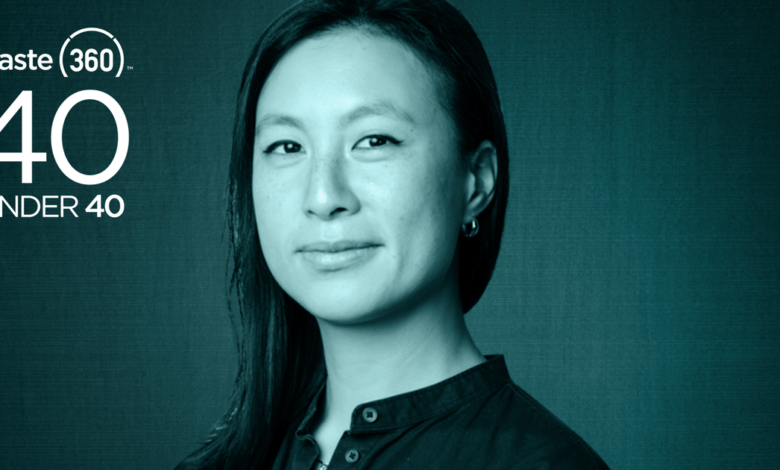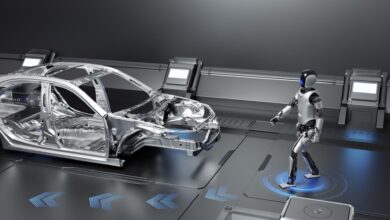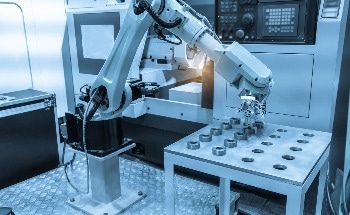Rebecca Hu’s Robots Empower Recyclers

Rebecca Hu is the CEO and founder of Glacier, a recycling startup building AI and custom robotics to help recyclers, brands, and governments increase their sorting efficiency, enhance worker safety, and use data to drive decision-making.
Hu, a 40 Under 40 award winner, spoke with Waste360 about why she founded Glacier, and why she thinks AI is the wave of the future for the industry.
This interview has been edited for length.
Waste360: How does AI, in your opinion, create revolutionary new solutions for recycling? What are some of the ways that you’re using it?
Rebecca Hu: AI is incredible because it allows us to adapt very quickly to an ever-changing waste and recycling stream. If you imagine some of the more legacy technology at MRFs, oftentimes, it was designed for a very particular packaging stream or very particular material stream. Over the years as producers come out with new types of packaging, and the preferences of consumers shift all the time, that type of static design can be really challenging to use over five, 10, 15, 20 years.
AI is constantly able to learn and update what it knows. For example, we often say, if we install one of Glacier’s robots at a MRF today, with the AI system that acts as the eyes of the robot, and a company comes up with a new type of packaging, five years from now, at that point in time we can still train our AI to identify, and then teach the robot to go after sorting that type of packaging, which is pretty incredible. I think it’s really that adaptivity and that robustness that is the true powerhouse behind AI technology.
Waste360: Can you clarify the separation between the AI solution and the robot sorting solution?
Rebecca Hu: The AI can be used in conjunction with the robot or as a standalone system. When the AI camera is paired with the robot, we usually refer to it as the eyes of the sorting system. If it’s just the AI camera on its own then it’s basically performing a monitoring task. It’s taking footage of the belt and then tabulating what it’s seeing over time.
I think in the past couple of years since Glacier was founded, we’ve seen these industry trends continue to emerge around the need to improve purity rates and decontaminate streams more than ever before. And then, also recover as much volume as possible and divert it from the landfill. The robot can actually help with both of these initiatives.
We built Glacier’s robot from scratch. The design is our own. We sourced all of the parts and integrated it together ourselves, and this is specifically to achieve some of the most important needs we heard from facilities. Namely, it needs to perform and pick at a certain consistency. It needs to have incredible uptime in a very harsh environment. It needs to be really easy to install in a fairly constrained location and easy to maintain by the team as well.
We realized that by going purpose-built for the MRF use case, that was the best way to make sure that we designed a robot that really fits these very specific MRF needs rather than buying a robot out of a catalog that could also be put in an auto assembly plant or a manufacturing facility.
In these MRFs, our robots perform, I’d say broadly two functions. The first is the decontamination function. We’ve actually spent many months doing custom R&D [research and development] to refine a robot that’s really good at decontaminating fiber streams. You can imagine putting it perhaps after your disc screen or your optical sorter, and that robot is actually able to identify things like plastic, film or black plastic, and then successfully suction it out and expel it into the residue shoot, or wherever you need that material to go in order to ensure significantly higher bale quality.
The second use case is basically maximizing diversion from the landfill so that you’re increasing your potential revenue of commodities, and you’re also reducing the volume that you have to send on to the landfill. In that regard, Glacier’s robot is consistently able to match the typical person that might be performing a similar function. We’ve seen that these robots are being put into locations that tend to be really difficult or dull, and those folks that may have been working at that station are able to be moved on to higher value streams, or potentially even upskill, to become mechanics and technicians that can take care of this type of equipment, rather than being the ones on the line having to pull all the materials as well.
Waste360: What are some of the challenges that you feel your company really tackles well for your clients?
Rebecca Hu: We give customers a lot more data in an actionable way and that empowers our customers to make decisions to improve their businesses and improve the state of recycling. The other one is essentially building this custom purpose-built robot that’s specifically designed to hit on everything that recycling facilities need in their automation.
One important thing we’re finding is that AI itself is obviously able to generate a huge amount of data on what is coming through a MRF, but the next frontier and something that we, at Glacier, really prioritize is, how do you actually make sense of the data and use it to drive action?
We know that MRF operators are incredibly busy. What we’re working on is trying to figure out what are the key metrics that MRF operators actually care about and how to return that information to them as quickly as possible.
Waste360: What advice would you give to a young professional starting their career or to someone who might want to launch their own waste industry business?
Rebecca Hu: My advice would be to stay curious. I think that for an industry that’s been around as long as waste and recycling there’s a reason why we do things a certain way. It’s because it’s worked, historically. But we are in unprecedented times.
There’s a lot of new landmark legislation coming out that’s going to start regulating the way that recycling and waste businesses operate. There’s a lot of new technology coming out, there’s constant societal and economic factors that are putting pressure on the whole recycling and waste industry to really rethink the way that they do business.
If you’re a young professional or someone looking to potentially start a new entrepreneurial endeavor, there’s a phrase that is oftentimes repeated in tech circles called “reasoning from first principles.” The idea here is really to try to abandon any notion of the way things are currently done and just look at the problem itself, and think about how you might try to tackle it if you didn’t know anything about it previously. I think that can spark some interesting new ideas for how to do things better or how to incorporate new tools, and it leads folks to embrace a more experimental mindset when it comes to bettering the outcomes for the entire industry.



